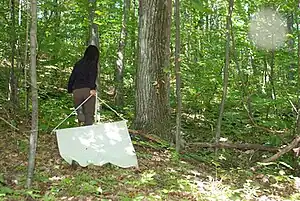Tick dragging is a method for collecting ticks used by parasitologists and other researchers studying tick populations in the wild.

Method
To conduct a tick drag, a researcher uses a 1-square-metre (11 sq ft) strip of white cloth, usually corduroy, mounted on a pole that is tied to a length of rope. The researcher drags the cloth behind themselves through terrain that is suspected of harboring ticks, working in a grid-like pattern. They may also "flag" low-lying bushes and other vegetation by waving the cloth over them.[1]
Tick dragging is one of several methods of harvesting wild ticks for study in the lab. In at least one trial, the tick dragging method proved more successful than more technologically innovative techniques, such as live-baited traps and CO2-baited traps.[2]
The dragging method is a useful way to collect ticks from a large area; CO2 trapping is another method for localized sampling of ticks. Different species of tick also have variable sensitivity or responsiveness to this form of trapping, so its effectiveness can vary with the species of tick the researcher is interested in sampling.[3]
The dragging method have been tested for its repeatability and reliability.[6] It was concluded that the cloth-dragging technique is useful both for surveying ticks' and to estimate and compare abundance between years and areas.[6]
History
The practice of dragging a large white cloth across suspected tick-infested terrain is described in biological field guides from the early 20th century.[4] More sophisticated methods have been developed, but the dragging method continues to be practised by researchers today.[5]
See also
References
- ↑ "Monitoring and Thresholds for Ticks". NPS on the Web. National Park Service, US Department of the Interior. 2010-01-19. Retrieved September 5, 2011.
- ↑ Richard C. Falco & Durland Fish (1992). "A comparison of methods for sampling the deer tick, Ixodes dammini, in a Lyme disease endemic area". Experimental and Applied Acarology. 14 (2): 165–173. doi:10.1007/BF01219108. PMID 1638929. S2CID 589283.
- ↑ Richard C. Falco & Durland Fish (1991). "Horizontal movement of adult Ixodes dammini (Acari, Ixodidae) attracted to CO2-baited traps". Journal of Medical Entomology. 28 (5): 726–729. doi:10.1093/jmedent/28.5.726. PMID 1941943.
- ↑ William Anson Hooker, F. C. Bishopp, Herbert Poland Wood & Walter David Hunter (1912). The life history and bionomics of some North American ticks. U.S. Dept. of Agriculture, Bureau of Entomology. pp. 9.
{{cite book}}: CS1 maint: multiple names: authors list (link) - ↑ Carey Goldberg (February 1, 2012). "The Ultimate Lyme Disease Map – So Far". CommonHealth. Trustees of Boston University. Retrieved September 18, 2012.
6. Kjellander, PL., Aronsson, M., Bergvall, UA., Carrasco, JL. Christensson, M., Lindgren, PE., Åkesson, M. & Kjellander, P. 2020. Validating a common tick survey method: cloth‑dragging and line transects. Experimental and Applied Acarology. doi: 10.1007/s10493-020-00565-4